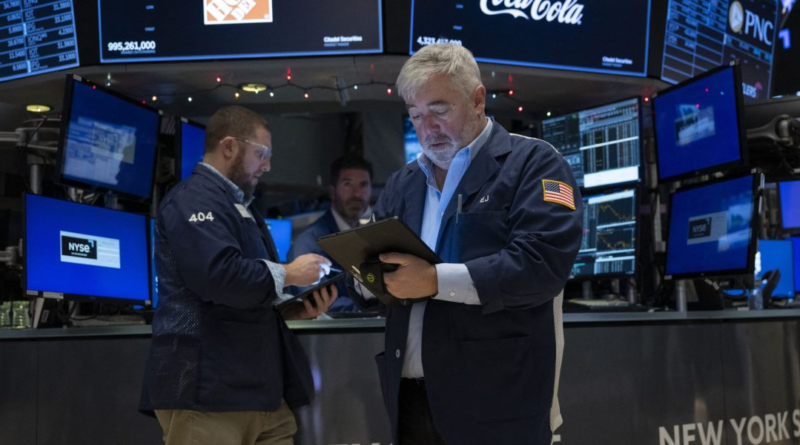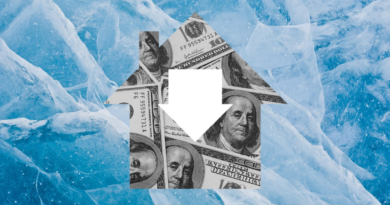Stocks are having their worst start to a new year since 2003 as they reverse their euphoric gains from the past few months
This isn’t how Wall Street hoped to ring in 2024.
Loaded up and bullish after a spirited holiday rally, investors were smacked with old worries in the new year, among them fresh questions about the path of Federal Reserve policy. The result: a cross-asset drubbing that surpassed any to start a year in at least two decades. The S&P 500 fell for the first time in 10 weeks, snapping the longest streak of gains in almost 20 years. Treasuries and corporate credit dropped the most since October.
For traders primed for interest-rate cuts in March, a hotter-than-forecast jobs report potentially blurred the outlook further on Friday. But the seeds of disillusionment were sown weeks before, when investors shed bearish wagers and dived into risky assets of all stripes. With the pool of new buyers running low, bulls were left to contend with a nagging sense they’d taken December’s euphoria too far.
To be sure, not much can be gleaned from a few days’ trading when it comes to how the year will unfold, history shows. Still, the swings were yet another reminder of the hazards of overconfidence when plotting the outlook for rate-sensitive strategies, especially after a year in which Wall Street efforts to predict market moves ended in misery.
“Investors were getting complacent and expecting a hat trick of fading inflation, stable job growth, and earnings up and to the right,” said Michael Bailey, director of research at FBB Capital Partners. “This week has muzzled some of the bulls.”
In a reversal from the everything rally in the final months of 2023, all major asset classes fell in the holiday-shortened week. Widely followed exchange-traded funds tracking equities and fixed income declined at least 1.5% over the first four sessions, the worst pan-markets slump to start a year since the two popular bond ETFs were created in mid-2002.
Though headwinds such as Apple Inc. downgrades and heavy corporate issuance weighed on markets, complacent investor positioning particularly around central-bank policy was the key accelerant. In fixed income, traders had viewed a Fed interest rate cut in March as a sure bet in late December. Now, the implied probability has been pared to around 70% or so. For all of 2024, swaps point to a total of 137 basis points of rate cuts, versus about 160 basis points last Wednesday. Much the same pattern played out in Europe.
The repricing drove 10-year Treasury yields back to 4%, retracing more than half of the decline since Dec. 13 when Fed Chair Jerome Powell laid the groundwork for monetary easing later this year. It’s easy to point finger at the lopsided positioning. A JPMorgan Chase & Co.’s survey showed its clients’ net long positions in the Treasuries market surged toward the highest since 2010 in November, before being gradually trimmed down since then.
“People wanted to jump on what is seen as a sea change, move from rates no longer going up,” said Alan Ruskin, chief international strategist at Deutsche Bank AG, on Bloomberg TV. “I think that made sense, but then the market just got ahead of itself. Now, we are in retreat.”
In the stock market, the pullback followed a flurry of buying that had sat uneasily with Wall Street contrarians. Aggregate inflows into US equity ETFs reached 0.18% of total market capitalization on a four-week total basis, the highest level in seven years, data compiled by Ned Davis Research show.
Hedge funds, which resisted chasing gains in November, gave in last month, with their net flows turning “meaningfully positive,” according to prime-broker data compiled by JPMorgan. While the broad exposure has yet to reach extreme levels, the swift bullish pivot sparked caution among the team led by John Schlegel.
Of particular concern was the pace at which fund clients unwound their bearish wagers. The amount of short covering since late October was larger than any period since 2018, aside from the pandemic rebound in March 2020. Similar episodes tended to herald imminent weakness, with the S&P 500 falling an average 5% to a bottom in the following month, Schlegel and his colleagues found.
At Goldman Sachs Group Inc., Tony Pasquariello also observed an explosion in optimism. On a scale of -10 to +10, he estimated that the fast money community’s equity exposure moved from -8 to +8 between October and December.
“While that certainly leaves plenty of room for imprecision, I’m confident in saying this: it’s really hard to see how the spec crowd can sustain the amount of firepower in January that was deployed in November and December,” Pasquariello, the firm’s head of hedge-fund coverage, wrote in a note.
Unhinged optimism played a role in a market rout that occurred, until Friday, in the absence of any major macroeconomic inputs. That suggests the selloff can be taken with a grain of salt. Three readings on consumer prices are scheduled before monetary officials convene in March in addition to fourth-quarter earnings reports from companies, often the occasion for updated guidance in the coming year.
As always, the path of profits remains paramount for equity investors. Analysts currently see an overall growth rate of almost 11% for the S&P 500, reflecting double-digit gains in health care, industrials, technology and communication-services companies. US large caps trade at 19.6 times those estimates, a high but not unheard-of valuation versus recent years.
“I actually think the technicals in the equity market are terrific,” Rick Rieder, chief investment officer of global fixed income at BlackRock Inc., said on Bloomberg TV. “There are some equities you could buy that are traded at three times cash flow, seven to 10 times earnings.”
Viewed through the lens of positioning, the picture arguably remains bearish. Tracking money supply and asset holdings across countries, JPMorgan’s model showed that investors from individuals to pensions and asset managers have seen cash holdings as a percentage of their total portfolios falling toward the lows at the end of 2021. While the dwindling cash pile is partly a function of a rally in stocks and bonds, it also indicates a drop in potential buying power, according to JPMorgan strategists including Nikolaos Panigirtzoglou.
“Our indicators currently point to elevated equity and bond positioning,” they wrote in a note. “There is currently a very low liquidity cushion to propagate financial assets further, thus posing downside risk to both equities and bonds going forward.”




